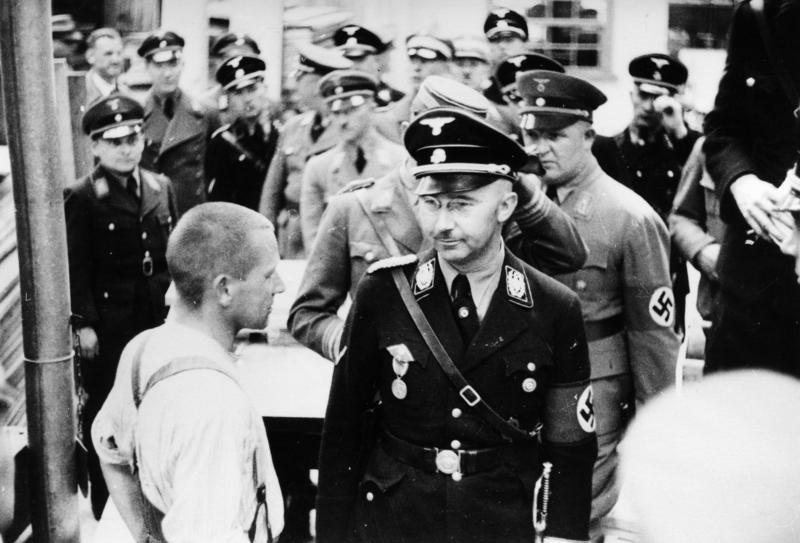Walter Heck on:
[Wikipedia]
[Google]
[Amazon]

 Walter Heck was a German graphic designer who created the SS double
Walter Heck was a German graphic designer who created the SS double
Signs of Evil – The Runes of the SS
', ZDF Info, 2016. 22.15.
 Walter Heck was a German graphic designer who created the SS double
Walter Heck was a German graphic designer who created the SS double rune
Runes are the letters in a set of related alphabets known as runic alphabets native to the Germanic peoples. Runes were used to write various Germanic languages (with some exceptions) before they adopted the Latin alphabet, and for specialised ...
symbol for the Nazi Schutzstaffel
The ''Schutzstaffel'' (SS; also stylized as ''ᛋᛋ'' with Armanen runes; ; "Protection Squadron") was a major paramilitary organization under Adolf Hitler and the Nazi Party in Nazi Germany, and later throughout German-occupied Europe d ...
in 1929, the SA-Runes badge, and co-designed the all-black SS uniform in 1932. He was a company commander in the Sturmabteilung
The (; SA; literally "Storm Detachment (military), Detachment") was the original paramilitary wing of the Nazi Party. It played a significant role in Adolf Hitler's rise to power in the 1920s and 1930s. Its primary purposes were providing pro ...
(SA), and later joined the SS.
Design of the SS symbol
Heck worked for Ferdinand Hoffstätter inBonn
The federal city of Bonn ( lat, Bonna) is a city on the banks of the Rhine in the German state of North Rhine-Westphalia, with a population of over 300,000. About south-southeast of Cologne, Bonn is in the southernmost part of the Rhine-Ru ...
, a company that made badges, and "worked in a studio focused on military designs."
In 1929, Heck designed the SS logo, not based on some ancient Aryan Germanic rune as mythologised by the Nazis, but because he wanted to move away from the Fraktur lettering
Fraktur () is a calligraphic hand of the Latin alphabet and any of several blackletter typefaces derived from this hand. The blackletter lines are broken up; that is, their forms contain many angles when compared to the curves of the Antiqua ...
ubiquitous in Germany at the time and also thought that the capital "S" used in the standard Latin alphabet was too soft to represent the values of the SS. He may also have been influenced by the double lightning bolt symbol used to warn people of a dangerous high voltage which is similar to the symbol that Heck designed. He was paid for his work (about $2). At the time, Heck was a company commander in the Sturmabteilung
The (; SA; literally "Storm Detachment (military), Detachment") was the original paramilitary wing of the Nazi Party. It played a significant role in Adolf Hitler's rise to power in the 1920s and 1930s. Its primary purposes were providing pro ...
(SA), and would later join the SS. By 1944 he was an Obersturmführer
__NOTOC__
(, ; short: ''Ostuf'') was a Nazi Germany paramilitary rank that was used in several Nazi organisations, such as the SA, SS, NSKK and the NSFK.
The rank of ''Obersturmführer'' was first created in 1932 as the result of an expan ...
.
In 1944, during the Second World War, a fellow officer wrote to Heinrich Himmler
Heinrich Luitpold Himmler (; 7 October 1900 – 23 May 1945) was of the (Protection Squadron; SS), and a leading member of the Nazi Party of Germany. Himmler was one of the most powerful men in Nazi Germany and a main architect of th ...
on Heck's behalf asking for some special consideration for Heck on account of the very small payment he had received for his design work on the SS symbol, and the fact that he was impoverished and had not retained any copyright on the design. Himmler wrote to Heck in response to say that, after the war was over, he intended to give Heck a family home with a garden but that he expected him to have started a family and have at least two children by then.Signs of Evil – The Runes of the SS
', ZDF Info, 2016. 22.15.
Other designs
Heck also designed the SA-Runes badge, a combination of a runic S and a Gothic A, and in 1932, withKarl Diebitsch
Karl Diebitsch (3 January 1899 – 6 August 1985) was an artist and the ''Schutzstaffel'' (SS) officer responsible for designing much of the SS regalia during the Nazi era, including the chained SS officer's dagger scabbard. Diebitsch worked with ...
, he designed the all-black SS uniform, not Hugo Boss
Hugo Boss AG, often styled as BOSS, is a luxury fashion house headquartered in Metzingen, Baden-Württemberg, Germany. The company sells clothing, accessories, footwear, and fragrances. Hugo Boss is one of the largest German clothing compani ...
as is often stated, although Boss's eponymous company, Hugo Boss AG
Hugo Boss AG, often styled as BOSS, is a luxury fashion house headquartered in Metzingen, Baden-Württemberg, Germany. The company sells clothing, accessories, footwear, and fragrances. Hugo Boss is one of the largest German clothing companies, ...
, did manufacture them.
Legacy
In 2017, the German television channelZDFinfo
ZDFinfo is a German free-to-air documentary television channel owned by ZDF. It was launched on 27 August 1997 as ZDFinfokanal, and later rebranded as ZDFinfo on 5 September 2011. On 1 May 2012, a high-definition simulcast
Simulcast (a por ...
released a 50-minute documentary ''Signs of Evil – The Runes of the SS'' from Silke Potthoff, which explored the history of the "SS" symbol and Heck's role in its design.
References
Further reading
* {{DEFAULTSORT:Heck, Walter German graphic designers Sturmabteilung officers SS-Obersturmbannführer German military personnel of World War II Year of birth missing Year of death missing